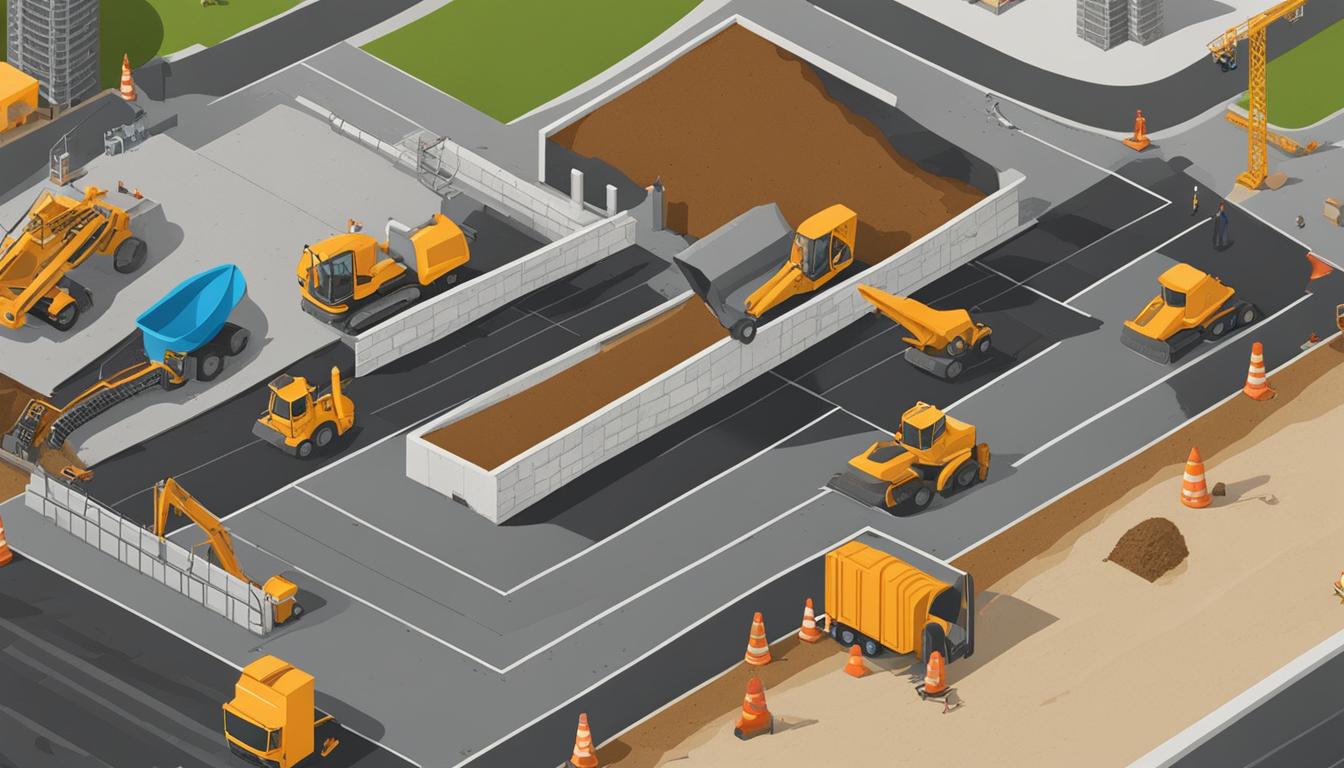When it comes to construction projects, the type of concrete you choose can greatly impact the final result. Concrete is a versatile material that can be customized to suit different environments and applications. Whether you’re building a foundation, laying a sidewalk, or creating decorative finishes, understanding the various types of concrete is essential for achieving the desired outcome.
Concrete and cement are often used interchangeably, but they are not the same thing. Concrete is a mixture of cement, sand, and gravel, while cement is a dry powder that binds the materials together. This distinction is important to keep in mind as we delve into the different types of concrete and their applications.
Key Takeaways:
- There are various types of concrete available for different applications.
- Concrete is a mixture of cement, sand, and gravel.
- Understanding the difference between concrete and cement is crucial.
- Concrete can be customized with different finishes and additives.
- Safety precautions should be taken when working with concrete.
Concrete vs. Cement
While concrete and cement are often used interchangeably, they are actually different materials with distinct properties. Cement is a dry powder that acts as a binding agent when mixed with water and aggregates. On the other hand, concrete is a composite material made up of cement, sand, gravel, and sometimes additives or reinforcements. Understanding the difference between concrete and cement is crucial for choosing the right material for your construction projects.
Concrete, with its combination of cement, sand, and aggregates, offers durability, strength, and versatility. It is commonly used for foundations, driveways, sidewalks, and various structural elements in buildings. Cement, on the other hand, is primarily responsible for binding the ingredients in concrete together. Without cement, the components of concrete would not adhere and form a solid mass.
It’s important to note that while cement may be a key component of concrete, it cannot be used alone as a construction material. Cement needs to be mixed with other ingredients to create concrete, and the proportions of these ingredients can vary depending on the specific application and desired characteristics of the end product.
Types of Concrete Mix
When it comes to concrete, there are various types of mixtures available for different construction projects. Understanding the characteristics and applications of each type of concrete mix is essential for achieving the desired results. Here, we will explore three common types: fast-setting concrete mix, high-strength concrete mix, and all-purpose concrete mix.
Fast-Setting Concrete Mix
Fast-setting concrete mix is designed for projects that require rapid setting and early strength development. It is commonly used for small-scale projects such as supporting fence posts or creating small concrete slabs. This type of concrete mix typically sets within 20 to 40 minutes, allowing for faster completion of time-sensitive projects.
High-Strength Concrete Mix
High-strength concrete mix is ideal for applications that require durability and structural integrity. It is commonly used for foundations, footers, and heavy equipment bases where strength is crucial. This type of concrete mix is engineered to withstand heavy loads and provide long-lasting performance.
All-Purpose Concrete Mix
All-purpose concrete mix is a versatile option that can be used for a wide range of applications. It is suitable for repairing foundation walls, laying sidewalks, creating steps, and setting posts. This type of concrete mix offers a balance between strength and workability, making it a popular choice for general construction projects.
By understanding the different types of concrete mix and their applications, you can ensure that your construction projects are completed with the right material. Whether you need fast-setting capabilities, high strength, or versatility, there is a concrete mix available to meet your specific needs.
Cement Types
When it comes to selecting the right cement for your construction projects, it’s important to understand the different types available. Cement is a key component in concrete, providing strength and durability to the final product. The three primary types of cement commonly used are:
- Portland Cement: This is the most common type of cement and is widely used in various construction applications. It provides a strong bond and is suitable for driveways, pathways, and general concrete projects.
- Masonry Cement: Designed specifically for use in masonry work, this cement type provides excellent strength and durability when building with bricks or stones. It is commonly used in commercial-grade structures.
- Mortar Mix: As the name suggests, this cement type is used primarily for laying bricks and stones. It creates a strong bond between the masonry units but is not suitable for providing structural support.
Each cement type has its own specific properties and uses, so it’s important to choose the right one based on your project requirements. Now, let’s take a closer look at the characteristics and applications of each cement type in the table below:
| Cement Type | Characteristics | Applications |
|---|---|---|
| Portland Cement | Provides a strong bond for concrete | Driveways, pathways, general concrete projects |
| Masonry Cement | Commercial-grade strength for brick or stone structures | Commercial buildings, masonry walls |
| Mortar Mix | Creates a strong bond for laying bricks and stones | Brick walls, stone structures, non-structural masonry |
By understanding the characteristics and applications of different cement types, you can make an informed decision and ensure the success and longevity of your construction projects.
Concrete Aggregates & Additives
Concrete is often enhanced with the addition of aggregates and additives, which play a crucial role in improving its quality and performance. Aggregates, such as gravel and crushed stone, add strength and stability to the concrete mixture. They provide bulk and fill the voids between the cement particles, resulting in a stronger and more durable end product.
Chemical additives are another important component of concrete. These additives can include plasticizers, accelerators, retarders, and air-entraining agents. Plasticizers, also known as water reducers, enhance the workability and flow of the concrete, making it easier to pour and shape. Accelerators speed up the curing process, allowing the concrete to gain strength more quickly. Retarders, on the other hand, slow down the setting time, which is beneficial in hot weather conditions or for projects that require longer workability. Air-entraining agents introduce tiny air bubbles into the concrete, improving its freeze-thaw resistance and durability.
“The addition of chemical additives to concrete allows for greater control and customization of its properties,” says John Smith, a concrete expert. “Whether it’s improving workability, reducing water content, or enhancing strength and durability, additives can significantly enhance the performance of concrete in various applications.”
Mineral additives, such as fly ash, silica fume, and slag cement, are also commonly used in concrete. These additives are by-products of other industrial processes and can replace a portion of the cement content in the mixture. Fly ash, for example, is a fine powder obtained from coal combustion, while silica fume is a by-product of silicon metal production. These mineral additives improve the concrete’s compressive strength, reduce shrinkage, and enhance its resistance to chemicals and harsh environments.
| Additive | Properties |
|---|---|
| Fly ash | Improves strength and durability, reduces permeability |
| Silica fume | Increases compressive strength, reduces bleeding and segregation |
| Slag cement | Enhances workability, improves resistance to alkali-silica reaction |
By incorporating aggregates and additives, concrete can be tailored to meet specific project requirements, whether it’s achieving higher strength, improving workability, or enhancing resistance to environmental factors. Contractors and engineers can choose from a wide range of options to create concrete mixtures that best suit their application needs.
Mixing Your Own Concrete
When it comes to small construction projects, mixing your own concrete can be a cost-effective and efficient option. By following a simple recipe, you can create a customized concrete mix that meets your specific needs. The most common type of cement used in concrete is Portland cement, which provides excellent strength and durability.
To mix your own concrete, you will need to gather the necessary ingredients: Portland cement, gravel, sand, and water. The recipe typically involves one part cement, 1 1/2 parts gravel, one part sand, and 1/2 part water. However, it’s important to adjust the mixture based on the desired consistency. Adding more or less water can make the concrete drier or wetter, respectively.
When mixing the concrete, be sure to use clean, acid-free water to prevent any chemical reactions that could weaken the mixture. It’s also important to wear protective gear, such as gloves and goggles, to avoid skin and eye irritation. Additionally, follow proper safety precautions to prevent any accidents or injuries while working with concrete.
| Ingredients | Ratio |
|---|---|
| Portland cement | 1 part |
| Gravel | 1 1/2 parts |
| Sand | 1 part |
| Water | 1/2 part |
By following this concrete mix recipe and taking the necessary safety precautions, you can successfully mix your own concrete for a variety of construction projects. Whether you’re repairing foundation walls, laying sidewalks, or setting posts, mixing your own concrete gives you greater control over the process and the final outcome.
How To Tell When Concrete Is Ready
When working with concrete, it is crucial to determine when it is ready for use. Here is a simple test that can help you assess concrete readiness:
- Smooth the surface of the concrete with the back of a shovel.
- Make a groove in the concrete using the side of the shovel.
- If the surface stays smooth and the sides of the groove hold their shape, the concrete is ready.
- If the groove caves in or the surface is not smooth, adjustments can be made by adding more dry ingredients or water.
Properly assessing concrete readiness is essential for ensuring successful construction projects. It allows you to determine if the concrete has reached the desired consistency and strength for the specific application.
Factors to Consider
Several factors can affect concrete readiness:
- Temperature: Concrete cures faster in warmer temperatures and slower in colder temperatures. Adjustments may need to be made to the mixture or curing conditions accordingly.
- Humidity: Higher humidity levels can slow down the curing process, while lower humidity levels can cause the concrete to dry too quickly. Monitoring humidity levels during curing is important.
- Concrete Mix: Different types of concrete mixtures have varying curing times. For example, high-strength concrete mix may require a longer curing period compared to a fast-setting mix.
By considering these factors and performing the simple test mentioned earlier, you can determine when the concrete is ready for the next stage of your construction project.
| Factors | Impact on Concrete Readiness |
|---|---|
| Temperature | Warmer temperatures accelerate curing, while colder temperatures slow it down. |
| Humidity | Higher humidity levels slow down curing, while lower humidity levels can cause the concrete to dry too quickly. |
| Concrete Mix | Different types of concrete mixtures have varying curing times. |
Safety Tips for Using Concrete
Working with concrete can be a rewarding experience, but it’s important to prioritize safety to prevent injuries. Here are some safety tips to keep in mind when using concrete:
- Wear protective gear: Concrete can be caustic and irritate or burn the skin. Always wear waterproof gloves and boots to protect yourself.
- Use a mask and protective eyewear: Concrete dust can be harmful when inhaled, so wearing a mask and protective eyewear is recommended to filter out dust particles and protect your eyes.
- Work in well-ventilated areas: When mixing or working with concrete, ensure that you are in a well-ventilated area to prevent the buildup of dust and fumes.
- Use proper lifting techniques: Concrete can be heavy, so it’s important to use proper lifting techniques to avoid strain or injury. Bend your knees and lift with your legs, rather than your back.
- Consider wearing knee pads and a hard hat: If you’re working on a construction site, wearing knee pads and a hard hat can provide additional protection against potential hazards.
By following these safety tips, you can minimize the risk of accidents and ensure a safe working environment when using concrete.
Reinforced Concrete
Reinforced concrete is a versatile construction material that combines traditional cement concrete with reinforcements, such as steel bars or mesh, to provide greater tensile strength. It is widely used in various infrastructure projects due to its durability and ability to withstand high pressure. The uses of reinforced concrete are extensive and include building foundations, roads, precast structures, and heavy-loaded structures.
One of the key advantages of reinforced concrete is its ability to bear heavy loads, making it suitable for constructing bridges, dams, and tall buildings. The reinforcement within the concrete adds strength and stability, ensuring that the structure can withstand the forces placed upon it. This makes reinforced concrete a preferred choice in projects where structural integrity is crucial.
In addition to its strength, reinforced concrete also offers excellent fire resistance properties. The steel reinforcement within the concrete provides an additional layer of protection against heat and flames, making it a reliable material for fire-resistant construction. This is particularly important in structures such as tunnels, parking garages, and industrial facilities.
Advantages of Reinforced Concrete:
- High strength and durability
- Ability to bear heavy loads
- Fire resistance
- Wide range of applications
“Reinforced concrete combines the best qualities of both concrete and steel, offering a reliable and efficient construction material for a wide range of projects.” – Construction Expert
Overall, reinforced concrete is a popular choice in the construction industry due to its versatility, strength, durability, and fire resistance. Its uses span across various sectors, from residential and commercial buildings to infrastructure projects. By combining the benefits of both concrete and steel, reinforced concrete provides a robust and reliable solution for creating long-lasting structures.
| Application | Uses |
|---|---|
| Building Foundations | Provides a solid and stable base for structures |
| Roads | Durable and long-lasting road surfaces |
| Precast Structures | Efficient and cost-effective construction method |
| Heavy-Loaded Structures | Supports heavy machinery and equipment |
Conclusion
In conclusion, understanding the different types of concrete is crucial for choosing the right material for your construction projects. Cement and concrete may be used interchangeably, but they are distinct substances. Concrete is a mixture of cement, sand, and gravel, while cement is a dry powder that binds the materials together.
There are various types of concrete mix available, including fast-setting concrete, high-strength concrete, and all-purpose concrete. Each type has its specific uses and benefits, whether you need a quick-setting solution or a durable foundation material.
When it comes to cement types, Portland cement, masonry cement, and mortar mix are commonly used. Portland cement is ideal for creating strong and sturdy concrete structures, while masonry cement and mortar mix serve different purposes in bricklaying and stone construction.
Lastly, it’s important to consider the aggregates and additives in concrete. Aggregates provide stability to the mixture, while additives can enhance its quality and performance. By mixing your own concrete, following the proper recipe, and assessing its readiness, you can ensure successful construction projects.
Remember to take safety precautions when working with concrete, as it can be caustic to the skin and harmful to the eyes. Wearing protective gear and following proper handling techniques will minimize the risk of injury.
In summary, having a good understanding of the types of concrete available, along with their characteristics and applications, will empower you to make informed decisions for your construction needs. By choosing the right concrete mix, cement type, and additives, you can ensure the success and durability of your projects.
FAQ
What is the difference between concrete and cement?
Concrete is a mixture of cement, sand, and gravel, while cement is a dry powder that binds the materials together.
What are the types of concrete mix?
The three common types of concrete mix are fast-setting concrete mix, high-strength concrete mix, and all-purpose concrete mix.
What are the types of cement?
The three common types of cement are Portland cement, masonry cement, and mortar mix.
What are concrete aggregates and additives?
Aggregates are the gravel in concrete that holds the mixture together. Additives can be chemical or mineral and enhance the quality of the mix.
How do I mix my own concrete?
The most common concrete mix recipe includes one part Portland cement, 1 1/2 parts gravel, one part sand, and 1/2 part water. Adjustments may be necessary based on desired consistency.
How do I determine when the concrete is ready?
You can determine if concrete is ready by smoothing the surface with the back of a shovel and making a groove with the side of the shovel. If the surface stays smooth and the sides of the groove hold their shape, the concrete is ready.
What safety precautions should I take when using concrete?
Safety precautions include wearing waterproof gloves and boots, a mask, and protective eyewear. Working in well-ventilated areas, using proper lifting techniques, and wearing knee pads and a hard hat are also advised.
What is reinforced concrete used for?
Reinforced concrete combines cement concrete with reinforcements, such as steel bars or mesh, to provide greater tensile strength. It is commonly used in infrastructure projects and heavy-loaded structures.


